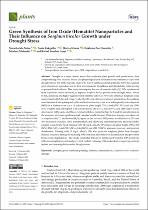Green synthesis of iron oxide (hematite) nanoparticles and their influence on sorghum bicolor growth under drought stress
| dc.contributor.author | Ndou, Nzumbululo | |
| dc.contributor.author | Rakgotho, Tessia | |
| dc.contributor.author | Nkuna, Mulisa | |
| dc.date.accessioned | 2023-05-02T12:46:28Z | |
| dc.date.available | 2023-05-02T12:46:28Z | |
| dc.date.issued | 2023 | |
| dc.identifier.citation | Ndou, N. et al. (2023). Green synthesis of iron oxide (hematite) nanoparticles and their influence on sorghum bicolor growth under drought stress. Plants, 12(7), 1425. https://doi.org/10.3390/plants12071425 | en_US |
| dc.identifier.issn | 2223-7747 | |
| dc.identifier.uri | https://doi.org/10.3390/plants12071425 | |
| dc.identifier.uri | http://hdl.handle.net/10566/8883 | |
| dc.description.abstract | Drought is a major abiotic stress that confronts plant growth and productivity, thus compromising food security. Plants use physiological and biochemical mechanisms to cope with drought stress, but at the expense of growth. Green-synthesized nanoparticles (NPs) have gained great attention in agriculture due to their environmental friendliness and affordability while serving as potential biofertilizers. This study investigates the role of hematite ( Fe2O3) NPs, synthesized from Aspalathus linearis (rooibos), to improve Sorghum bicolor growth under drought stress. About 18 nm, spherical, and highly agglomerated hematite ( Fe2O3) NPs were obtained. Sorghum seeds were primed with 5, 10, and 15 mg/L Fe2O3 NPs, and, after seven days of germination, the seedlings were transferred into potting soil, cultivated for fourteen days, and were subsequently water deprived (WD) for a further seven days. | en_US |
| dc.language.iso | en | en_US |
| dc.publisher | MDPI | en_US |
| dc.subject | Drought | en_US |
| dc.subject | Green synthesis | en_US |
| dc.subject | Nanoparticles | en_US |
| dc.subject | Sorghum bicolor | en_US |
| dc.subject | Biotechnology | en_US |
| dc.title | Green synthesis of iron oxide (hematite) nanoparticles and their influence on sorghum bicolor growth under drought stress | en_US |
| dc.type | Article | en_US |

